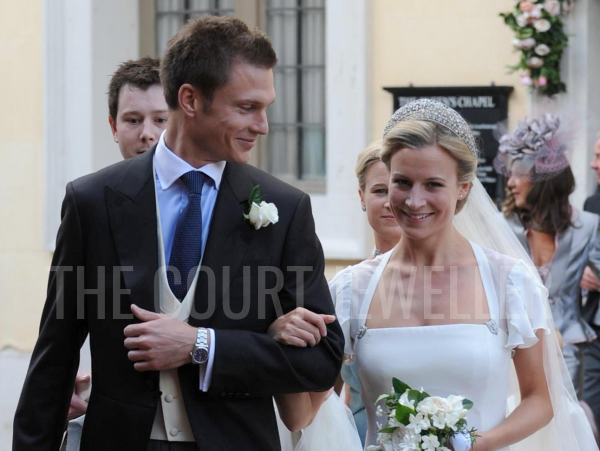 |
| Photo licensed to The Court Jeweller. DO NOT REPRODUCE. |
Royal Brides at St. George’s Chapel
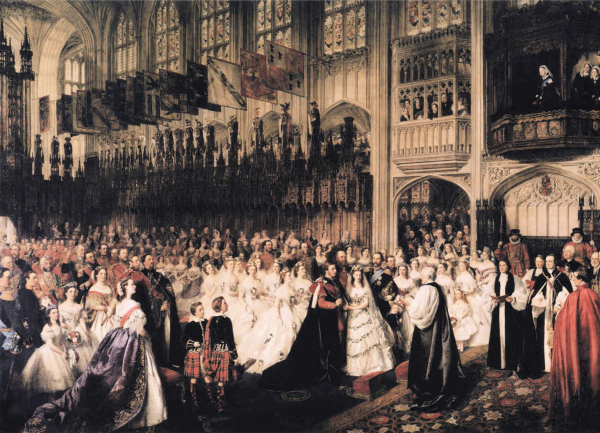 |
| William Powell Frith’s painting of the marriage of the Prince and Princess of Wales at St. George’s Chapel, 1863 (Wikimedia Commons) |
On Saturday, Prince Harry and Meghan Markle will become the latest in a long line of royal couples married at St. George’s Chapel, the castle chapel of Windsor Castle. The chapel is a special spot: it’s the chapel of the Order of the Garter, and it’s also a royal peculiar, which means it’s under the direct jurisdiction of the monarch, not a particular diocese. Although it’s officially titled a “chapel,” the building is huge, seating hundreds of people, and it houses the burial places of numerous monarchs and royals. Today, we’re looking at the royal (and almost-royal) weddings that have taken place within the chapel’s walls.
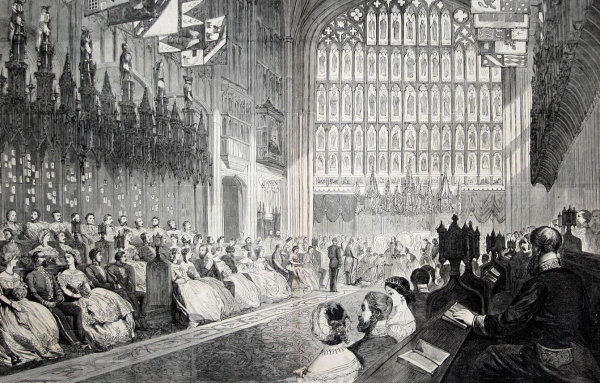 |
| Engraving from Harper’s Weekly of the wedding of the Prince and Princess of Wales at St. George’s Chapel, 10 March 1863 (Wikimedia Commons) |
The choice of St. George’s for the wedding of the Prince of Wales (later King Edward VII) and Princess Alexandra of Denmark (later Queen Alexandra) in March 1863 was an unexpected one. Most royal weddings in the past century had taken place in the Chapel Royal at St. James’s Palace, and the Times reported that “the decision that the marriage shall take place at Windsor has caused a deep and general disappointment in London.” The venue had been chosen by the groom’s mother, Queen Victoria. His biographer, Jane Ridley, explains that Victoria “insisted that [having the wedding at St. George’s Chapel] had been Albert’s wish, but insiders thought the Queen’s real reason for cheating London’s show-loving crowds of a royal wedding was the fact that in St. George’s Chapel she could watch the ceremony unseen from Catherine of Aragon’s closet.”
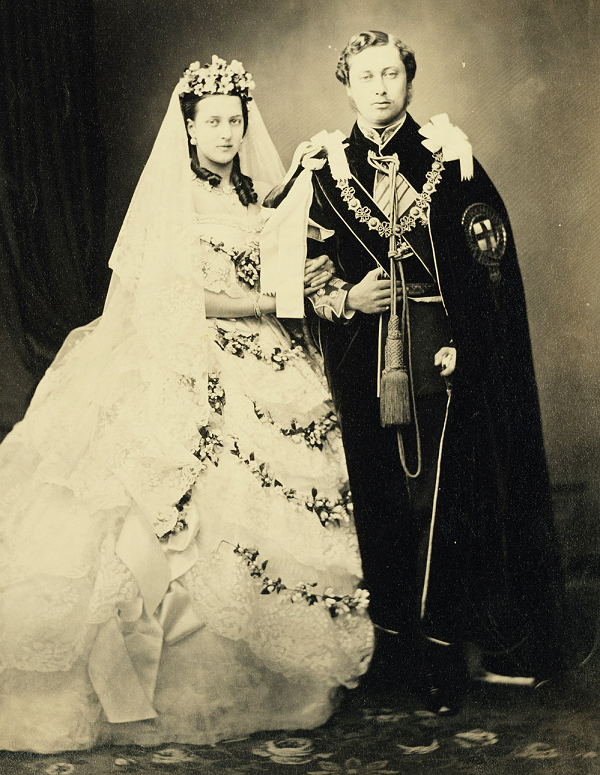 |
| The Prince and Princess of Wales (later King Edward VII and Queen Alexandra) on their wedding day, 10 March 1863 (Wikimedia Commons) |
And that’s precisely what she did. Queen Victoria, wearing black, fairly hovered over the top of the couple as they said their vows at the chapel’s altar, looking down from the royal closet. The groom wore the robes of the Order of the Garter for the ceremony, and the bride was magnificent in a dress of Brussels lace provided by the groom’s great-uncle, King Leopold of Belgium. She also wore a pearl and diamond necklace, brooch, and earrings made by Garrard, a gift from her new husband. After the wedding, the newlyweds departed for a honeymoon at Osborne House on the Isle of Wight.
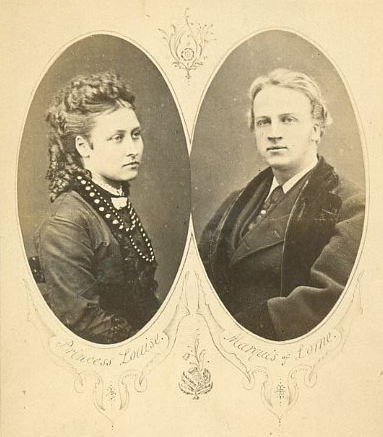 |
| Engagement photographs of Princess Louise and the Marquess of Lorne (later the 9th Duke of Argyll) |
In March 1871, another of Queen Victoria’s children, Princess Louise, was married at St. George’s. (Five years earlier, Princess Helena had also married at Windsor — but in the private chapel, not at St. George’s.) Louise’s wedding drew intense public attention, partly because her groom, the Marquess of Lorne (later the 9th Duke of Argyll), was a Scottish aristocrat, not a foreign prince. The Morning Post sighed, “The interest so deeply felt in every member of the Royal Family was upon this occasion deeply intensified by the fact that a new page of history was being illustrated by the union of a Princess with a subject. The marriage is, therefore, emphatically one of Love, and consequently enlists the sympathy of the nation.”
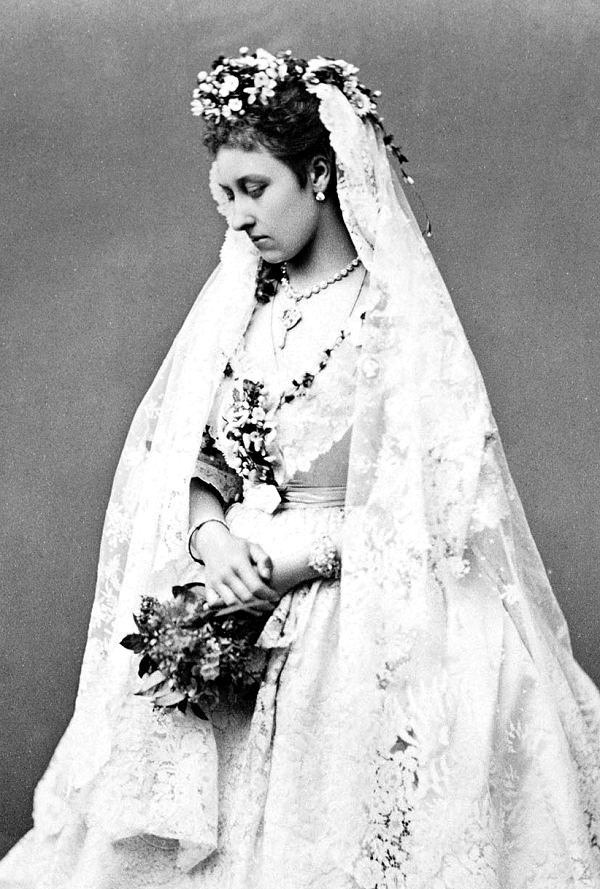 |
| Princess Louise on her wedding day, 21 March 1871 (Wikimedia Commons) |
This time, Queen Victoria didn’t sequester herself in the royal closet. She was a part of the bridal procession, walking with the Prince of Wales on her right and her brother-in-law, the Duke of Saxe-Coburg and Gotha, on her left; the bride followed immediately after the trio, wearing a gown of white satin, with orange blossoms adorning her hair. The Guardian‘s special correspondent approved of the venue on the day: “St. George’s Chapel is too well known to need much description. Whenever I enter it I am always reminded of the late Duke of Cambridge’s often-repeated declaration that he would never have his old bones rattled down to that cold damp hole at Windsor. But to-day the bright sunlight gave something of warmth and cheerfulness to the gloomy shadow-obscured edifice.” After the ceremony, a grand wedding breakfast was held in the Waterloo Chamber inside the castle.
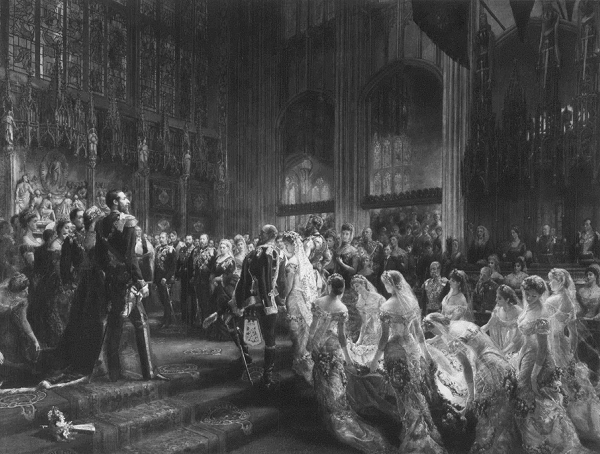 |
| Sydney Prior Hall’s painting of the wedding of the Duke and Duchess of Connaught at St. George’s Chapel, 13 March 1879 (Royal Collection) |
Queen Victoria’s seventh child, the Duke of Connaught, looked across the pond to find his royal bride, Princess Louise Margaret of Prussia. They married at St. George’s Chapel in March 1879; the wedding was supposed to take place earlier, but it was postponed after the death of the groom’s sister, Princess Alice. By this time, everyone was accustomed to royal weddings happening at Windsor, and the Standard reported that the “town was gaily decked, and jubilantly thronged. Hundreds of strangers had streamed in from the outlying districts and from afar.” Schoolboys from Eton, located near Windsor Castle, gathered to run alongside the royal carriages.
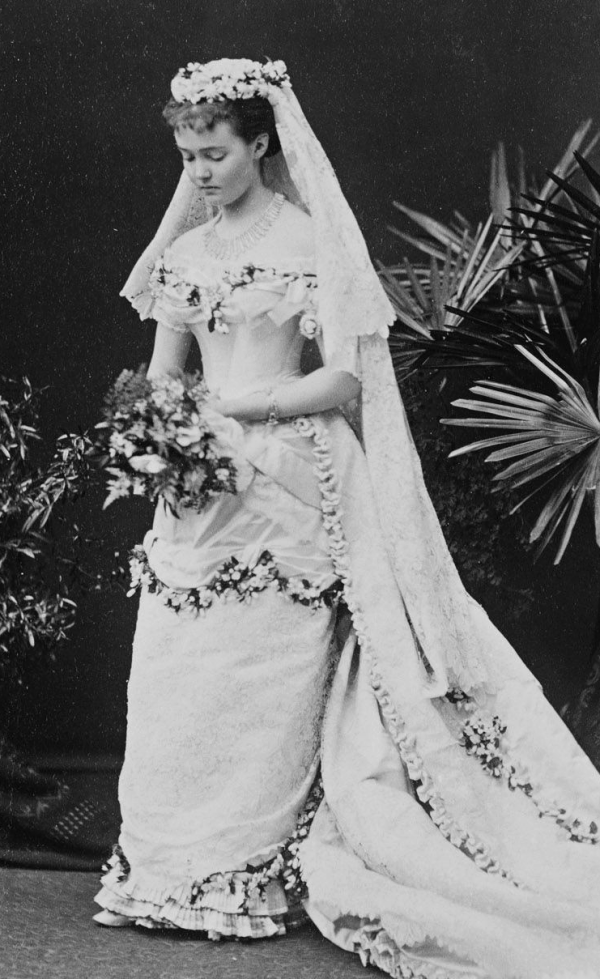 |
| The Duchess of Connaught on her wedding day, 13 March 1879 |
Princess Louise Margaret, escorted by her father, Prince Friedrich Carl, wore a white satin gown festooned with lace. Diamond stars, a gift from her new husband, secured her veil; she also wore a diamond fringe necklace given to her by Queen Victoria. Louise later wore the diamond fringe as a tiara at the coronation of her brother- and sister-in-law, King Edward VII and Queen Alexandra.
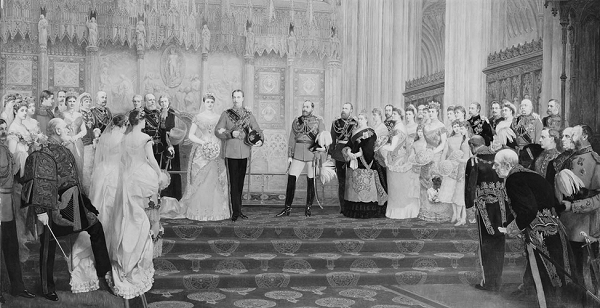 |
| Sir James Linton’s painting of the wedding of the Duke and Duchess of Albany at St. George’s Chapel, 27 April 1882 (Royal Collection |
When Queen Victoria’s youngest son, the Duke of Albany, married Princess Helena of Waldeck and Pyrmont, in April 1882, Windsor Castle received a gleaming upgrade. The Morning Post explained that the castle was “illuminated by the Compton Electric Light company,” a display “intended to illuminate the whole of the palace and terrace,” and “seen for miles around.” The light in St. George’s Chapel itself also attracted the attention of a reporter from the Times, who wrote, “A curious play of light and shade, caused by the fitful sunshine, heightened the beauty of the spectacle. The chapel was by turns wrapped in gloom and suffused with a golden splendour. At the supreme moment a dark cloud which had been obscuring the sun passed away and a beautiful halo of light tinted with the many hues of the stained glass windows seemed to envelop the bride and bridegroom as they stood before the altar.”
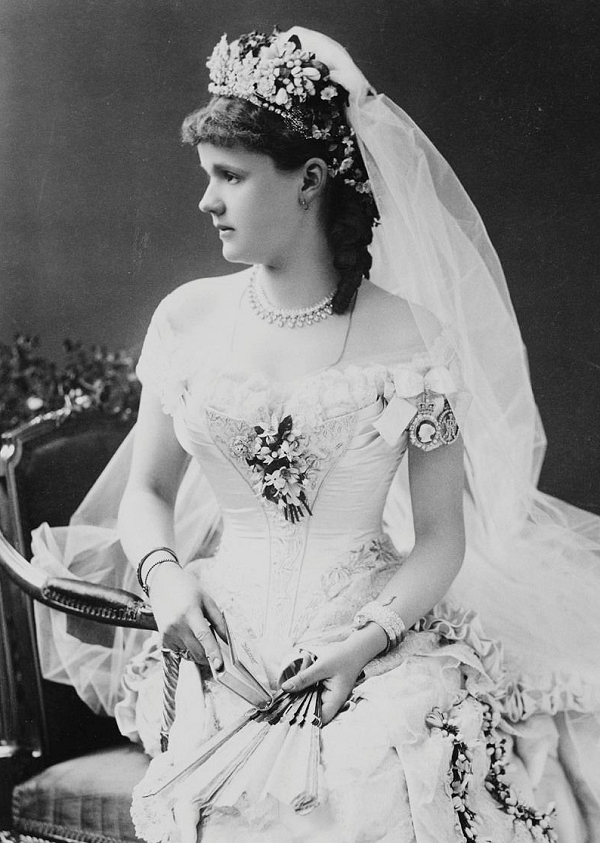 |
| The Duchess of Albany on her wedding day, 27 April 1882 |
Princess Helena arrived at St. George’s on the arms of her father, the sovereign Prince of Waldeck and Pyrmont, and her brother-in-law, King Willem III of the Netherlands. Her white satin wedding dress, made in Paris, was a gift from her sister, Queen Emma of the Netherlands; her wedding jewels included a fringe-style necklace, a gift from her parents, and a fashionable serpent bracelet. A wedding breakfast was held in the Waterloo Chamber, and that evening the Queen threw a state banquet in St. George’s Hall.
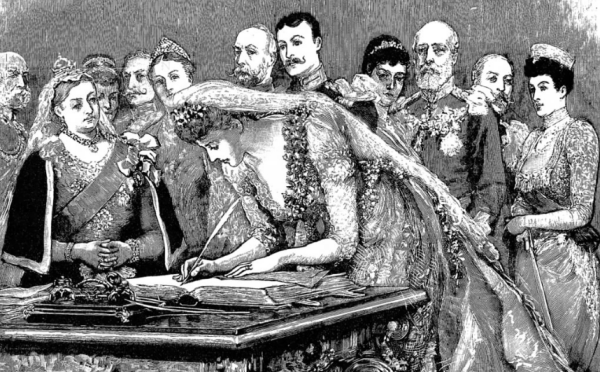 |
| An illustration from the Graphic depicting Princess Marie Louise signing her wedding register in the Green Drawing Room at Windsor Castle, 6 July 1981 |
The first of Queen Victoria’s grandchildren to marry at St. George’s Chapel was Princess Marie Louise of Schleswig-Holstein, who married Prince Aribert of Anhalt in July 1891. (Marie’s parents, Prince and Princess Christian of Schleswig-Holstein, had married in the castle’s private chapel 25 years earlier.) The marriage ended rather disastrously, but the wedding day itself was highly anticipated. The entire British royal family attended, and so did Emperor Wilhelm II and Empress Augusta Victoria of Germany. “No wonder, then,” the Morning Post mused, “that the people of Windsor and its neighbourhood took a public holiday, that the shops were closed, that thousands of people lined the roads, and that every house, even in the bye streets, where no Royal person was likely to pass, displayed some sort of decoration.”
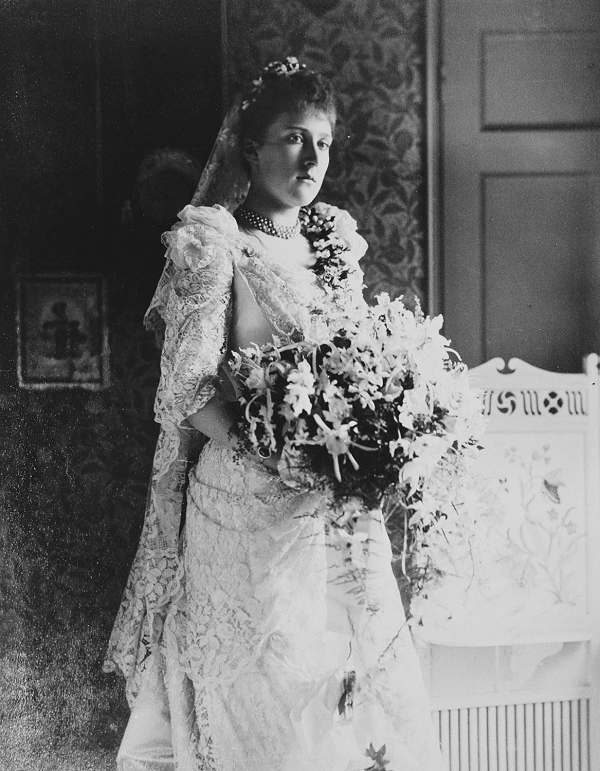 |
| Princess Marie-Louise on her wedding day, 6 July 1891 (Royal Collection) |
Unfortunately, the weather didn’t fully cooperate: the spectators who had gathered were doused by intermittent rain showers. The bride, though, was a vision in a white lace gown. She carried an enormous bouquet of orange blossoms. Prince Aribert wore a green uniform. After the couple had departed for their honeymoon at Cliveden, Queen Victoria took a special carriage ride through the streets to enjoy all of the decorations set out by the people of Windsor.
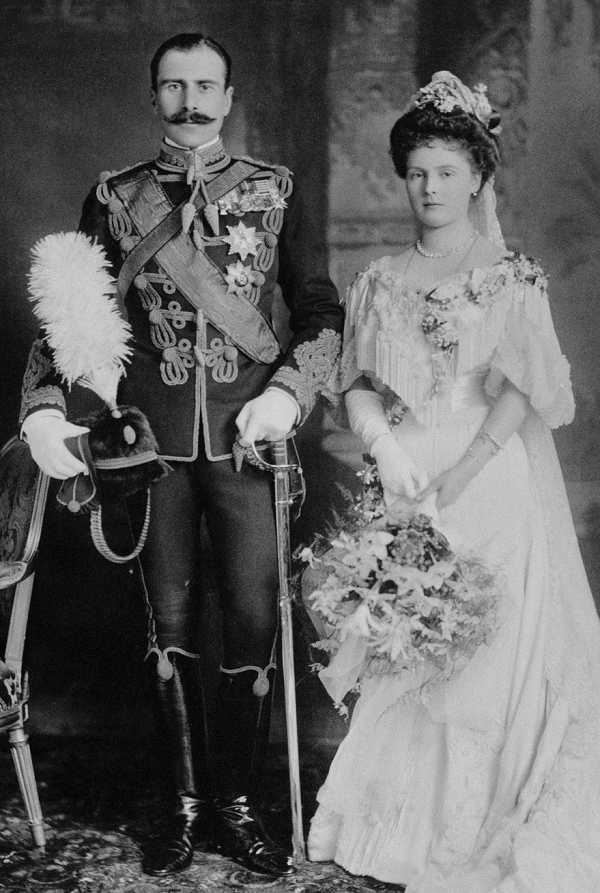 |
| Prince and Princess Alexander of Teck on their wedding day, 10 February 1904 (Royal Collection) |
The first 20th century royal wedding at St. George’s Chapel happened in February 1904, when Princess Alice of Albany, niece of King Edward VII, married Prince Alexander of Teck, son of the Duke and Duchess of Teck. Although Alexander was a member of the German House of Württemberg, his mother was a granddaughter of King George III, and he’d been born at Kensington Palace and educated at Eton and Sandhurst.
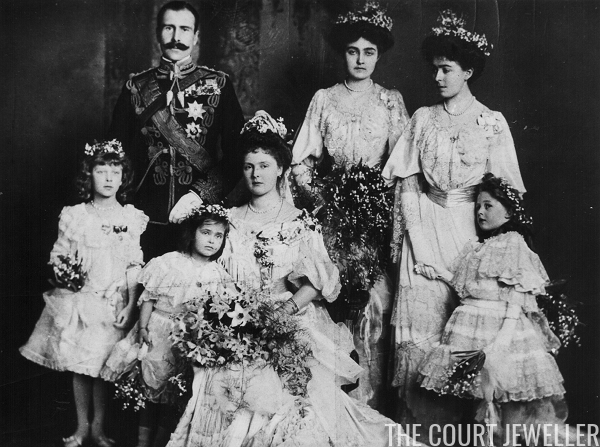 |
| Prince and Princess Alexander of Teck on their wedding day with their bridal party (Princess Margaret of Connaught, Princess Patricia of Connaught, Princess Mary of Wales, Princess Mary of Teck, and Princess Helena of Waldeck and Pyrmont), 10 February 1904 (Keystone/Hulton Archive/Getty Images) |
St. George’s hadn’t hosted a royal wedding in more than a decade, and significant preparations were made to the interior and exterior of the building. Inside, the Times reported that the “middle of the nave” was “railed off with bronzed and gilt standards” and “carpeted with crimson cloth.” Outside, large awnings were build near the clock tower “in order to shelter the King’s guests when alighting from or entering their carriages.” Even better, for the first time “arrangements [were] made at Windsor Castle for the convenience of a sufficient number of the representatives of the press.”
Three queens attended the nuptials: Queen Alexandra (the bride’s aunt), Queen Emma of the Netherlands (the bride’s aunt), and Queen Charlotte of Württemberg. The bride wore a gown of white satin charmeuse and carried a large bouquet. She also wore several diamond ears of wheat ornaments in her hair, a gift from her new husband. The newlyweds spent the first part of their honeymoon at Brocket Hall.
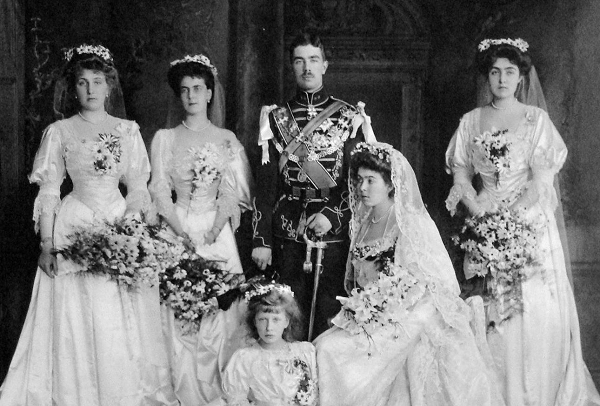 |
| Prince Gustaf Adolf and Princess Margareta of Sweden on their wedding day with their bridal party (Princess Ena of Battenberg, Infanta Beatriz of Spain, Princess Mary of Wales, and Princess Patricia of Connaught), 15 June 1905 (Wikimedia Commons) |
A year later, one of Princess Alice’s bridesmaids, Princess Margaret of Connaught, married Prince Gustaf Adolf of Sweden (the future King Gustaf VI Adolf) at St. George’s Chapel. For the first time since the wedding of King Edward VII and Queen Alexandra, the chapel hosted the wedding of a future monarch. Princess Margaret also followed in the footsteps of her parents, the Duke and Duchess of Connaught, who married in the chapel in 1879. On the day before the wedding, King Edward VII and Queen Alexandra, uncle and aunt of the bride, threw a garden party at Windsor.
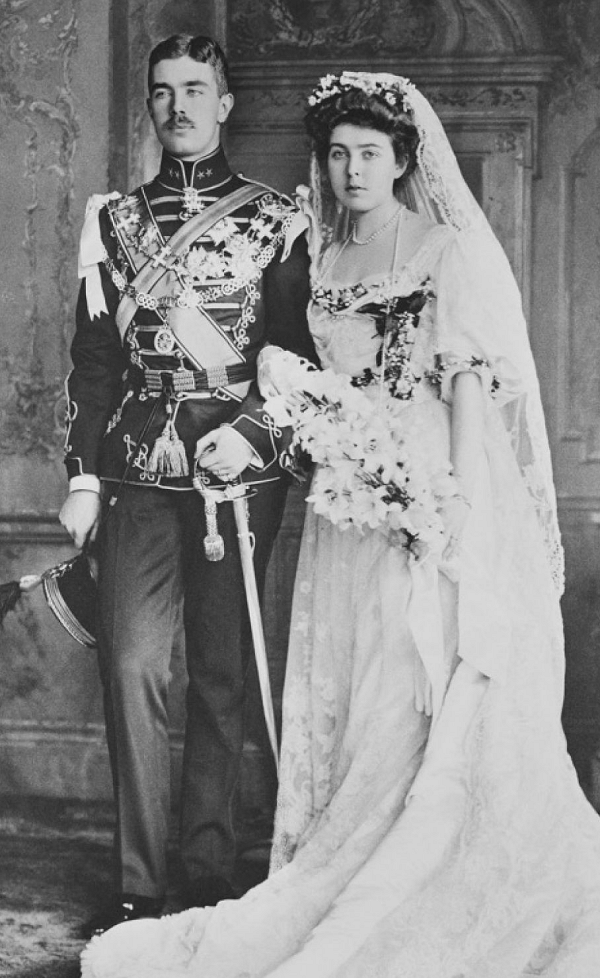 |
| Prince Gustaf Adolf and Princess Margareta of Sweden on their wedding day, 15 June 1905 |
Princess Margaret’s wedding gown was made of ivory satin and lace, with a full court train. Her veil, made of Irish lace, has been worn by several of her descendants at their own weddings. She wore orange blossoms in her hair, and the Guardian reported that her only jewels “were pearls which had belonged to her grandmother, the late Queen Victoria.” Her wedding gifts included numerous jewels, however, which are now worn by her descendants in various royal families, including royals from Sweden, Denmark, and Greece.
The British papers carefully recorded that congratulations had been sent to King Oscar II of Sweden by the people of Norway, which was then ruled in a personal union with Sweden. Only days before the wedding, the Norwegian parliament had introduced a bill to dissolve that union, and by October, Sweden had recognized Norway as an independent constitutional monarchy. Intriguingly, the Norwegians elected Prince Charles of Denmark and his wife, Princess Maud (a cousin of Princess Margaret) as their new King and Queen. Charles and Maud, whose names were already being discussed by the British press in connection with the vacant throne, did not attend the royal wedding, having departed for Copenhagen on June 1.
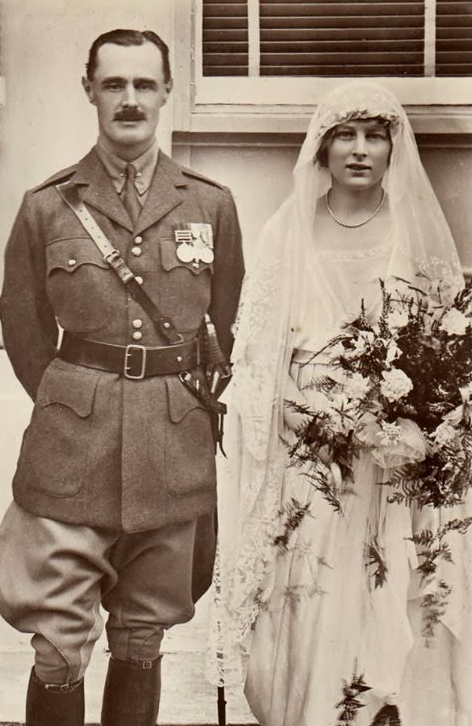 |
| Major John and Lady Helena Gibbs on their wedding day, 2 September 1919 |
More than a decade went by before the next St. George’s Chapel wedding, which united Lady Helena Cambridge, a niece of Queen Mary, and Major John Evelyn Gibbs of the Coldstream Guards, a veteran of the Great War. The marriage took place on September 2, 1919, with the “hearty approval” of King George V and Queen Mary, although neither were in attendance at the ceremony. The King did generously offer the couple the use of Frogmore House for a reception following the service, after which they traveled to Major Gibbs’s family’s estate, Tyntesfield, in Somerset.
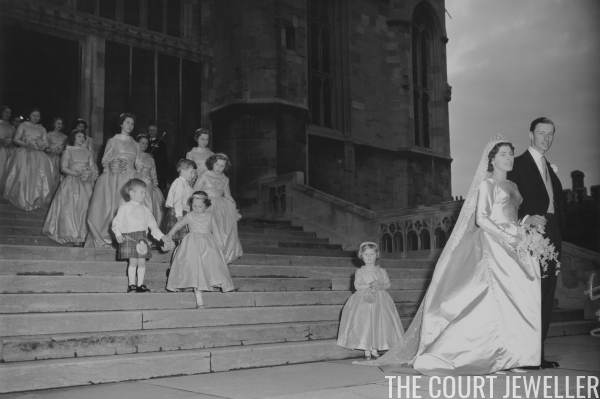 |
| David and Anne Liddell-Grainger on the steps of St. George’s Chapel with their bridal party, including Princess Beatrix of the Netherlands, Princess Irene of the Netherlands, and Princess Christina of Sweden, 14 December 1957 (Ron Burton/Keystone/Hulton Archive/Getty Images) |
St. George’s Chapel didn’t hold another major wedding until 1957, when Anne Abel Smith, a granddaughter of the Earl and Countess of Athlone, married the Scottish politician David Liddell-Grainger. The bride’s gown was made of champagne satin, and she wore a veil that originally belonged to Queen Mary. Her tiara, made of ears of wheat, was borrowed from her grandmother, Princess Alice, Countess of Athlone (who also wore the wheat ornaments at her St. George’s Chapel wedding in 1904).
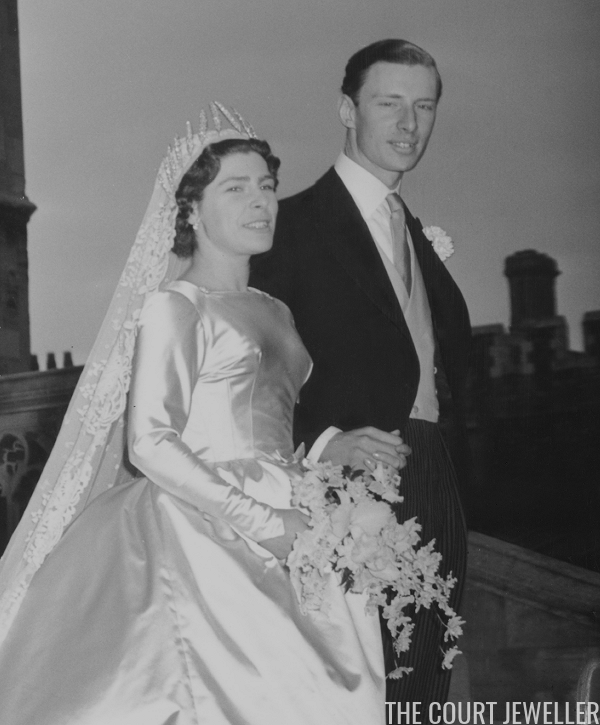 |
| David and Anne Liddell-Grainger on their wedding day, 14 December 1957 (Ron Burton/Keystone/Hulton Archive/Getty Images) |
The wedding was attended by numerous royals, including the Queen and members of the British royal family, Princess Sibylla of Sweden, and Queen Juliana of the Netherlands. The bride’s family ties to the Swedish and Dutch royals were also emphasized in her choice of bridesmaids. The Observer noted that “Princess Beatrix and Princess Irene, daughters of Queen Juliana, and Princess Christina, a daughter of Princess Sibylla of Sweden, were among the eight grown-up bridesmaids, who wore gowns of gold organza.”
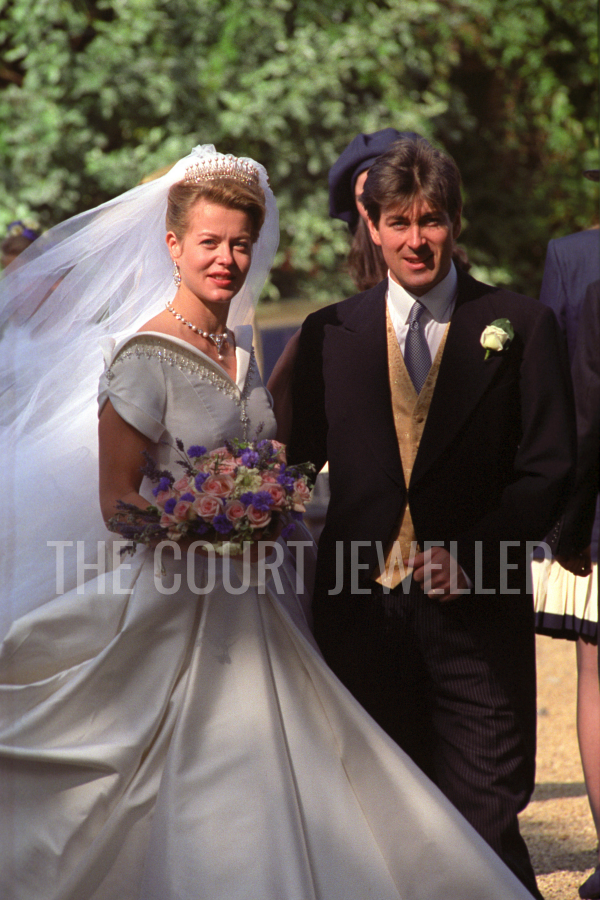 |
| Timothy and Lady Helen Taylor on their wedding day, 18 July 1992 (Photo licensed to The Court Jeweller; DO NOT REPRODUCE.) |
As the House of Windsor dealt with turmoil in several other royal marriages, Lady Helen Windsor (daughter of the Duke and Duchess of Kent) offered a welcome distraction when she married Timothy Verner Taylor at St. George’s Chapel in July 1992. The press was largely preoccupied by the presence of the Princess of Wales and the Princess Royal and the absence of the Duchess of York, but the Observer wrote that the wedding “at the ancient chapel of St. George in the precincts of Windsor Castle was the social occasion of the year.” With her white silk Catherine Walker gown, Helen wore a diamond and pearl fringe tiara borrowed from her mother.
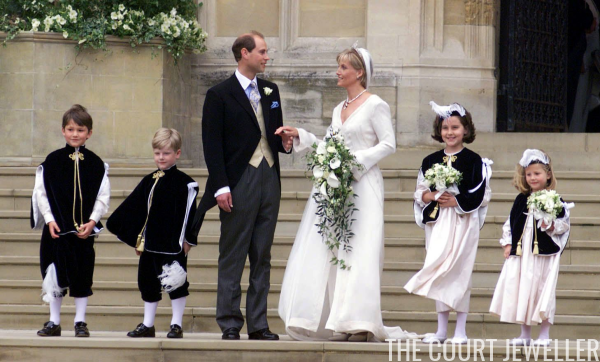 |
| The Earl and Countess of Wessex and their bridal party on their wedding day, 19 June 1999 (JOHN STILLWELL/AFP/Getty Images) |
In June 1999, the child of a reigning monarch married at St. George’s Chapel for the first time in over a century when the Earl of Wessex wed Sophie Rhys-Jones. The Washington Post called it “the simplest and most subdued royal wedding Britain has seen for decades,” arguing that the couple chose St. George’s because it “would preserve as much privacy as possible from a wedding that was broadcast around the world.” The location inspired parts of the wedding, including the bridesmaid and page boy outfits that echoed the robes of the Order of the Garter.
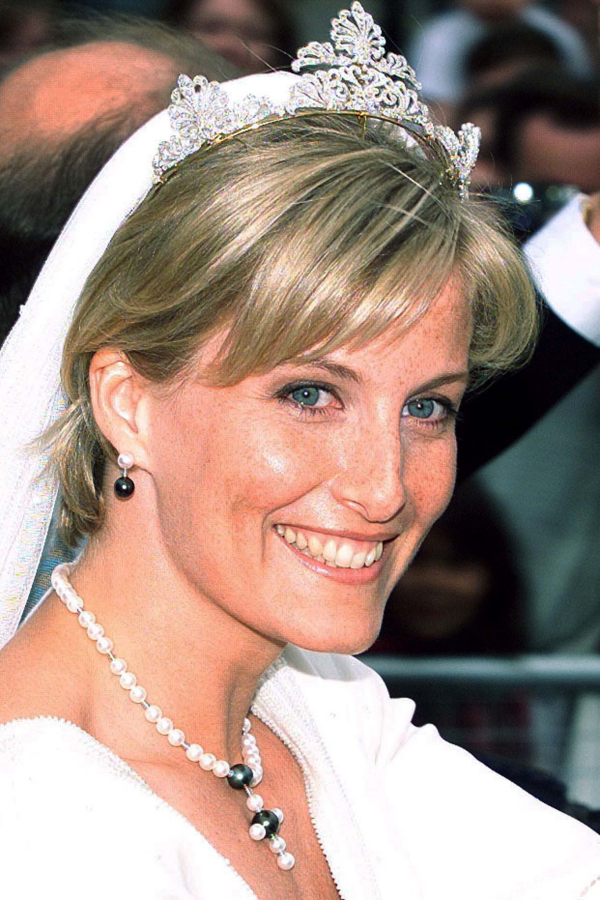 |
| The Countess of Wessex on her wedding day, 19 June 1999 (DAN CHUNG/AFP/Getty Images) |
Sophie’s wedding attire included an ivory silk organza gown and matching coat designed by Samantha Shaw, as well as a diamond tiara that the press noted was “from the collection of Queen Victoria, which Queen Elizabeth had the royal jeweler refurbish for the occasion.” (Really the tiara seems to have been created for the wedding using discarded anthemion elements from Victoria’s Regal Circlet.) Her pearl necklace and earrings were designed for her by the groom.
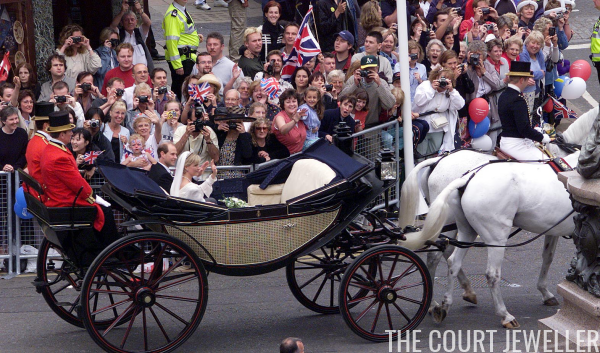 |
| The Earl and Countess of Wessex greet the people of Windsor during thier post-wedding carriage ride, 19 June 1999 (MARTYN HAYHOW/AFP/Getty Images) |
After the wedding ceremony, the couple gathered on the windy steps of the chapel with their families. The Observer noted that “pealing bells and jumbo jets” — a modern consequence of Windsor’s location in one of Heathrow’s flight paths — “drowned out most of the photographers’ cries of despair when Edward decided not to give his new Countess of Wessex a kiss as they stood on the steps.” Afterward, the bride and groom hopped in a carriage for a tour through the streets of Windsor.
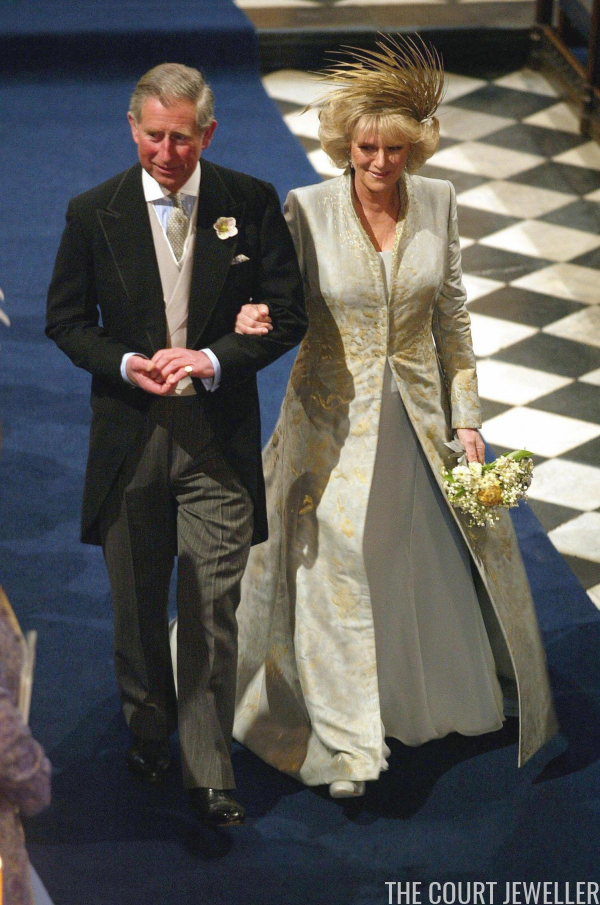 |
| The Prince of Wales and the Duchess of Cornwall on their wedding day, 9 April 2005 (CHRIS YOUNG/AFP/Getty Images) |
After a civil wedding ceremony at the Guildhall in Windsor, the Prince of Wales and the Duchess of Cornwall had their marriage blessed by the Archbishop of Canterbury in a ceremony at St. George’s Chapel in April 2005. The wedding had been postponed by a day to allow the groom to attend the funeral of Pope John Paul II at the Vatican, but the delay didn’t dampen the couple’s joy. The new duchess arrived for the blessing in an elegant pale blue and gold coat by Robinson Valentine, as well as a Philip Treacy headpiece, described by the Associated Press as “a coronet of gilded plumes tipped with crystals.”
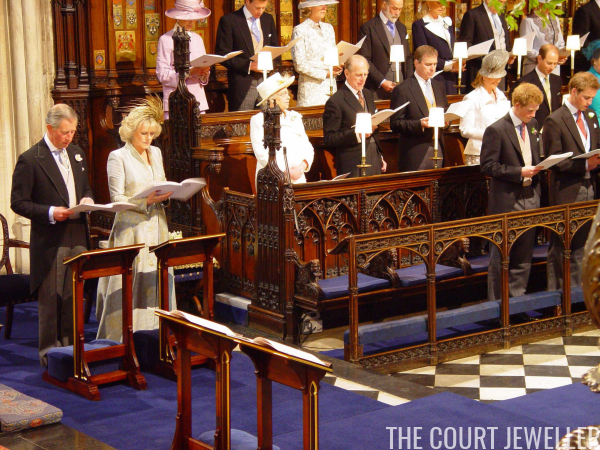 |
| The blessing of the marriage of the Prince of Wales and the Duchess of Cornwall at St. George’s Chapel, 9 April 2005 (CHRIS YOUNG/AFP/Getty Images) |
The blessing was attended by all senior members of the royal family, as well as a few foreign royals. An estimated 15,000 people crowded the town on the wedding day. “Among the thousands who lined Windsor’s main street to catch a glimpse of Prince Charles and the Duchess of Cornwall,” the Associated Press reported, “were staunch monarchists, Diana-loving Camilla-haters and simple royal watchers who buzzed with the thrill of witnessing the wedding of the heir to the throne.” During a reception held in Windsor Castle after the ceremony, the Queen dispelled any doubts that she approved of the union in a touching speech: “They have come through and I’m very proud and wish them well. My son is home and dry with the woman he loves.”
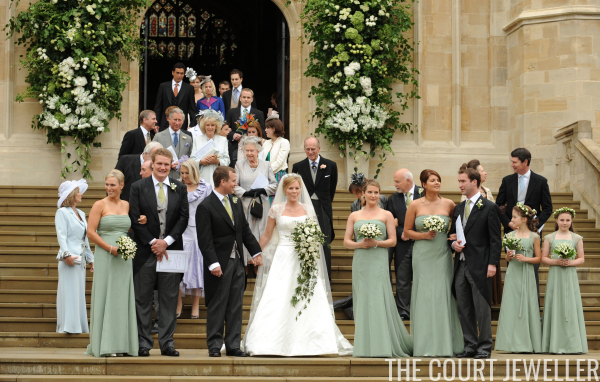 |
| Peter and Autumn Phillips gather with their wedding party and their families on the steps of St. George’s Chapel, 17 May 2008 (IAN MCILGORM/AFP/Getty Images) |
The most recent royal-adjacent union at St. George’s Chapel was the wedding of Peter Phillips, son of the Princess Royal, and Autumn Kelly. They were married at the chapel, surrounded by members of the royal family, in May 2008. The bride, who had recently converted from Catholicism to Anglicanism, wore a gown by Sassi Holford and her mother-in-law’s diamond festoon tiara.
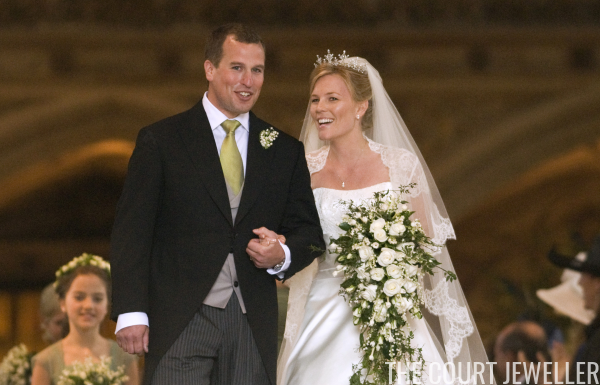 |
| Peter and Autumn Phillips on their wedding day, 17 May 2008 (IAN MCILGORM/AFP/Getty Images) |
The Queen allowed the couple to hold their wedding reception at Frogmore House. Photographers captured both the wedding and reception for a magazine spread, paying special attention to two non-royal guests: Kate Middleton, the then-girlfriend of Prince William, and Chelsy Davy, girlfriend of Prince Harry. The Associated Press noted that “Phillips and Kelly raised eyebrows in some quarters by agreeing to sell the story of their nuptials to the celebrity magazine Hello! for a sum reported at up to $1 million.”
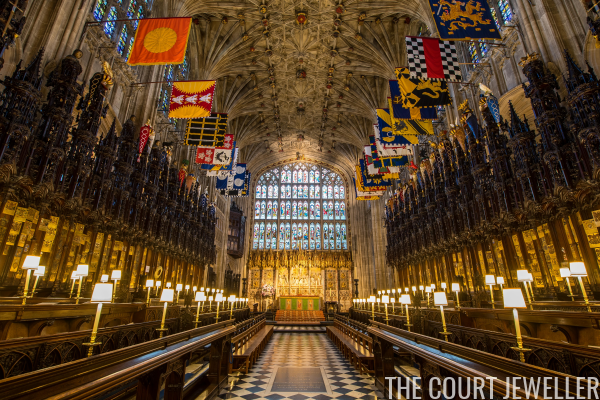 |
| An interior view of St. George’s Chapel, Windsor Castle, February 2018 (DOMINIC LIPINSKI/AFP/Getty Images) |
A decade later, St. George’s Chapel will host not one but two royal weddings this year — the first time that has ever happened in the chapel’s history. On Saturday, Prince Harry will wed Meghan Markle at the chapel, and in October Princess Eugenie will marry Jack Brooksbank. Windsor may be a smaller venue for royal weddings, and it may lack the space and infrastructure that London offers, but it offers a more intimate — but still very royal and historical — space to marry.
The Daily Diadem: Princess Anne’s Festoon Tiara
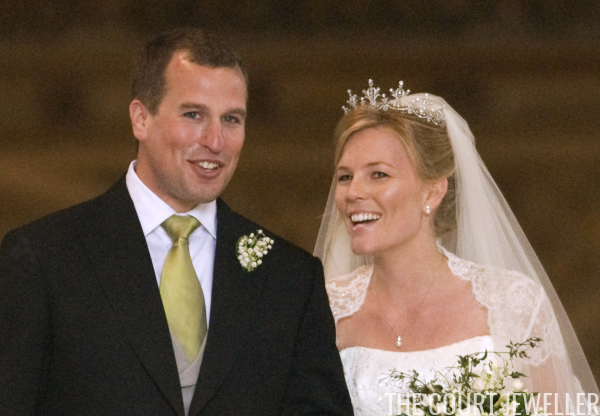 |
| IAN MCILGORM/AFP/Getty Images |
- « Previous Page
- 1
- …
- 55
- 56
- 57
- 58
- 59
- …
- 126
- Next Page »